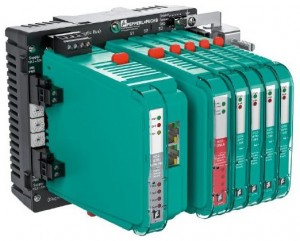Seamless technology transfer
Standards guarantee the seamless interaction of devices and systems. But technical development never stops and the process automation world is already approaching the next technology generation. However, this time it is not about something completely new but rather about merging established solutions.
Digitalization has already taken over the process industry and an increasing number of chemical process plants have changed to data communication via PROFIBUS PA. At the same time, automation systems are still a world of their own. They offer full transparency from the control center all the way down to individual field devices. Yet, their systems and standards have little to do with the world of information technology where Ethernet is the established communication standard from servers to desktop computers and even mobile devices.
With PROFINET this separation into two technology worlds is finally approaching its end. PROFINET is not only based on Industrial Ethernet which allows a transparent flow of information way beyond the process plant. PROFINET also includes the well-established technologies of PROFIBUS PA and is therefore fully compatible with the requirements of process control systems.
Key technologies opening news opportunities
The Chemical Industry is operating in highly competitive international markets. This means, process plants need to be flexible and offer maximum efficiency in combination with superior availability. PROFIBUS PA offers the best technological basis to achieve such goals. It supports a seamless communication infrastructure which allows having an eye on each individual field device and solve recognizable problems way before they can lead to a plant shutdown.
PROFINET can do the very same. But PROFINET goes one step further. It is the very first platform to allow fully transparent communication between the automation technology and the IT world. This turns PROFINET into a key technology which opens the process world to the latest trends, such as Industry 4.0, Big Data and the Internet of Things. Thanks to PROFINET systems will be able to analyze the huge amount of process and device data which a chemical process plant generates continuously. This not only offers a completely new insight into the process and will lead to new levels of knowledge. It also frees the access to the plant from time and space limitations and enables completely new applications for optimized and flexible process control.
Technology upgrade in small steps
Chemical process plants not only expand over large areas. They are also governed by such vital aspects as process reliability and explosion protection. Since PROFIBUS PA perfectly matches such requirements it has developed into an internationally established standard for the chemical process industry. For example, it allows digitally integrating field devices into the control system and linking them seamlessly with an Asset Management System. This is supported by the standard PA profile which guarantees the compatibility of devices independently from manufacturers in order to allow easy exchange of devices.
Although automation specialists are fully aware of the additional advantages offered by PROFINET, most plant operators are not ready yet to opt for a general technology upgrade. That’s why organizations such as PROFIBUS & PROFINET International work on migration paths supporting a gradual change from an existing PROFIBUS PA based system environment to a comprehensive PROFINET network.
Industrial Ethernet as core argument
The typical scenario in the chemical industry is a complex process plant that is controlled by field devices and infrastructure components resembling different technology generations. Such a heterogeneous system environment does not only represent a true challenge as far as system maintenance and technical service are concerned. It also calls for numerous interfaces which usually only allow limited compatibility and prevent a truly transparent view of the process plant. Not to forget the relatively strict separation between the automation world at plant level and the IT systems of an organization.
PROFINET offers ideal conditions to unite different system worlds. PROFINET is not only well established in the manufacturing industry for many years. PROFINET is also based on the well-known Industrial Ethernet which was expanded to include PROFIBUS DP functionality.
In other words, PROFINET is not a completely new system, but basically combines the best of two worlds. That’s why insiders are convinced that PROFINET will be the communication infrastructure of the future. This is emphasized by characteristics, such as standardization, consistency, ease of operation, and security. Not to mention advantages such as cost reductions, considerably higher efficiency, and a completely new range of applications.
Manufacturers are getting on board
Manufacturers of infrastructure components are also aware of the development and start offering new solutions on the basis of PROFINET. For the plant operator this considerably simplifies the setup of a consistently homogeneous communication infrastructure ranging from each individual field device all the way to the control room.

The same is true of the latest generation of Plant Management Systems. The effectiveness of such systems increases considerably if they can access a wealth of data provided by the latest generation of field instruments and other devices. PROFINET is the key to realize the vision of a process plant that monitors itself and offers everything needed to realize targeted servicing and wear-dependent maintenance concepts.
Supported by a PROFINET-enabled Asset Management System, maintenance technicians will always be aware of upcoming problems and know exactly where and when maintenance work will be required. This will not only turn plant shutdowns into rare situations. If they do occur, the service technician will be fully prepared when he arrives on site, because the system not only issues an alarm message, but also provides specific information on the type of problem that has caused the shutdown.
New components for new opportunities
PROFINET will be a key aspect of a new generation of infrastructure components. Typical examples are the new Power Hubs of the FieldConnex® range from Pepperl+Fuchs. It consists of power supplies for up to four fieldbus segments which are used to supply power to the field devices directly via the signal line.

The latest generation Power Hubs are not only considerably more compact than previous models, but they also feature a lower level of power loss on the market. They also allow connecting more field devices. A completely new component added to the line is the PROFINET gateway. It allows a direct and electrically separated connection between PROFINET and PROFIBUS PA without the need of any additional devices.
Using a Device Type Manager or web server, a Power Hub can be configured and diagnosed comfortably from any remote location. It also comes with configuration tools for all established automation system on the market. Additionally, the integrated Advanced Diagnostic Module supports the continuous monitoring of the physical fieldbus layer.
Using PROFINET as the enabling technology not only leads to a considerable increase of operating safety, efficiency, and availability of a process plant. PROFINET also allows easy integration into IT systems and the use of a new generation of applications in relation to Big Data, Industrie 4.0, and the Industrial Internet of Things. The combination of PROFIBUS DP and PROFINET is a migration path leading directly into the future and paving the way for a wealth of totally new opportunities.
 Andreas Hennecke
Andreas Hennecke
Product Marketing Manager
Pepperl+Fuchs
Process Automation Division
Member, PI Advisory Board
